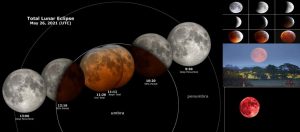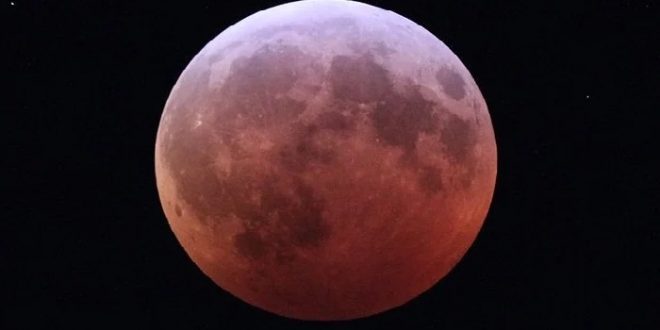26-05-2021
Bureau Report
WASHINGTON/ KARACHI: The first lunar eclipse of 2021 will take place today (Wednesday. However, the spectacle will not be visible in Pakistan due to daylight.
The Super Flower Blood Moon had already taken place at 11:39am in the day while the total lunar eclipse is supposed to take place from 4:11-5:05pm.
A lunar eclipse occurs when the moon moves into the earth’s shadow. It happens only when the sun, earth, and moon are exactly or very closely aligned, with earth between the other two, which can only happen at the night of a full moon.
“It might be hard to detect a supermoon visually, but it does have an effect on Earth. Because the Moon is in its closest approach to Earth, it can cause higher tides than usual,” says NASA.
For stargazers that do not reside in Pakistan but across the Asia Pacific and the Americas, tonight will serve as a treat for them. People in the Americas and the Asia Pacific will have a rare chance to witness a “Super Flower Blood Moon”.
As per astronomers, the Super Flower Blood Moon is a once-in-a-decade phenomenon during which the moon turns orange-red.
 When the moon is closed to the Earth, it is known as a Super Moon. The Super Moon is the result of the first total lunar eclipse in more than two years taking place at the same time as the moon is closest to Earth.
When the moon is closed to the Earth, it is known as a Super Moon. The Super Moon is the result of the first total lunar eclipse in more than two years taking place at the same time as the moon is closest to Earth.
The reason the moon will turn red tonight is because sunlight will refract on to it through the Earth’s atmosphere. The color varies with each eclipse and the more dust or clouds in the Earth’s atmosphere; the more redder will be the colour of the moon.
The spectacle will be safe for the naked eye to witness, say experts.
Experts classify a Super Moon when the moon is closest to the Earth’s surface, at a distance of 360,000 kilometers (225,000 miles).
When that happens, the moon appears 30% brighter and 14% larger than when it is farthest from the Earth– 50,000km (30,000 miles).
The phenomenon is already generating much hype around the world, according to the Sydney Observatory.
“Interest has been high,” Andrew Jacobs, a curator of astronomy at Sydney Observatory, told media.
For those who want to see the spectacle live with their own eyes and not on a streaming service on the internet, Jacob has suggested that the best places where the moon will appear are “Australia, New Zealand, and large parts of the Pacific. New Guinea also gets a good view.”
“The Americas see it in the early morning, but they don’t necessarily see all parts of the eclipse,” he said.
NASA’s Bill Cooke also has a few places where people will get to witness the entire eclipse.
“Folks in Hawaii and the Aleutian Islands will get to see the entirety of this eclipse – it will be quite a show for them,” he tweeted.
Those who can witness the moon are indeed lucky for the next Super Blood Moon will take place in 2033.
 Pressmediaofindia
Pressmediaofindia




